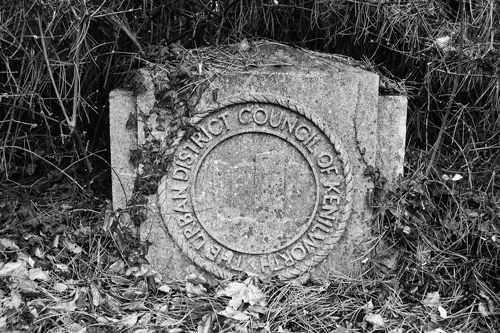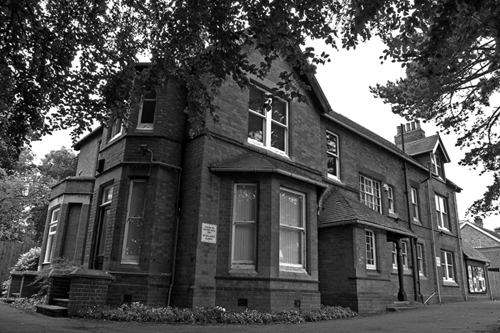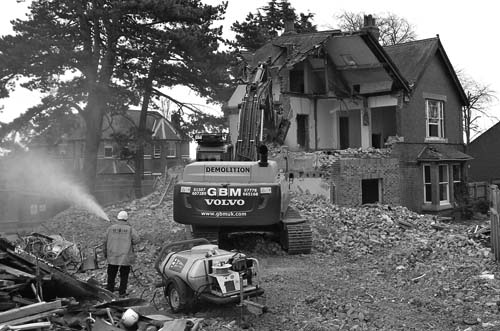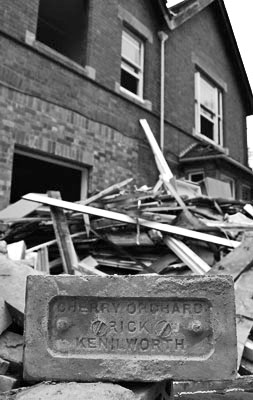Wilton House Relic
(Published in the Kenilworth Weekly News, 13th January 2012)

The impending demolition of Wilton House in Southbank Road will result in a little known Kenilworth relic being put on public display.
In the garden is this hefty piece of stonework, almost 2 feet high, inscribed ‘The Urban District Council of Kenilworth’ and having a slightly raised carving of the castle in its centre.
Its origin has been revealed to me by several people, it was once part of the public conveniences in Station Road! I have been unable to discover when the conveniences were built, but I suspect the 1920s.
They were in the news in 1962 when the turnstile-entrance to the ‘Ladies’ was removed. New conveniences were built soon after at the rear of the then new Talisman Square, but when the Station Road conveniences were closed in 1974, they were replaced with new ones built at Abbey End.
It was when being demolished in 1975 that the pictured stonework was removed for safekeeping to the grounds of the Council Offices, Wilton House.
I have been told that plans are in place to move the stone to the front of the Community Centre at Smalley Place, where it will be ‘conveniently’ placed for all to see. Everyone concerned should be congratulated; it is too interesting an artefact to ‘lose’.
Not surprisingly, photographs of Kenilworth’s public conveniences are rare, if anybody should have a photograph of those in Station Road, please contact me through this website.
(Update: The relic was moved into Kenilworth Town Council storage on 30th March 2012, and later placed outside Jubilee House.)
Wilton House
(Published in the Kenilworth Weekly News, 27th January 2012)

This week, the Victorian ‘Wilton House’ joined the long list of fine Kenilworth buildings now demolished.
It was built for Arthur Ledbrook, a partner in a firm of Warwick solicitors, and he had moved in by 1900. With him were his wife, three young sons William, Hugh, and Arthur, and daughter Eileen.
In 1901 at Wilton House, Ledbrook hosted the meeting at which the still-surviving tennis club was formed, as he did many of the club’s subsequent gatherings.
The Ledbrooks were hit by tragedy just before the Great War. In 1913, William then just 21, died in Wales and the following year Hugh, then also 21, was one of four victims of Kenilworth’s famous typhoid outbreak.
The next owner of Wilton House was Arthur Street, then Chairman of the KUDC and proprietor of the fellmongers works at Mill End (on what is now Woodmill Meadow). He had an extension built on the rear to use as a billiards room and it was that room that became first the Urban District Council and then the Town Council chamber; a room where much of post-war Kenilworth’s developments have been discussed and approved.
At some point in the 1950s, the greenhouses were removed from Wilton House to the Cemetery Lodge to enable Parks Superintendent Jack Drew to grow flowers for decorating the town.
With permission from the developers, I have spent a couple of hours investigating the empty house and there was still much of interest in the surpsingly complicated layout. The original internal walls survived; the service area with the kitchen still had tiled flooring and its own staircase up to the servants quarters in the roof space; the main staircase led from the entrance hall and had a fine stained glass window, part of which has been rescued.
On the basement wall was a gas lamp, I would suggest one of the very last in Kenilworth in its original position. This too, has been saved for posterity.
Sadly, this is my last regular contribution to the ‘Kenilworth Nostalgia’ page for a while; having written around 40 articles since Carrie became our local reporter, it is time to take a break. Many thanks to those that have taken the trouble to contact me, to help fill little gaps in recording the past of this marvellous town of ours. It is perhaps fitting I should end on the demolition of a house so full of history.
Addendum:
‘Wilton House’ was demolished between 21st and 27th February 2012. Unsurprisingly, bricks made in Kenilworth were found amongst the rubble, samples from both the Cherry Orchard and Whitemoor brickworks were seen.


The complete history of Wilton House features in Kenilworth People and Places, Volume 2.